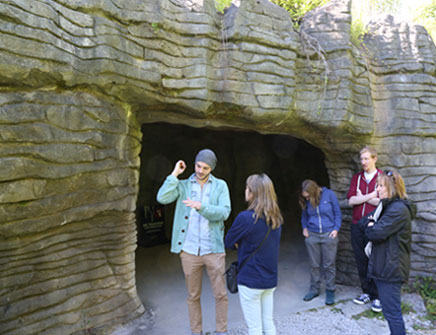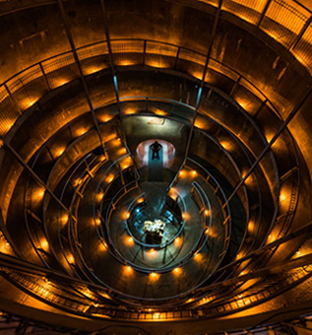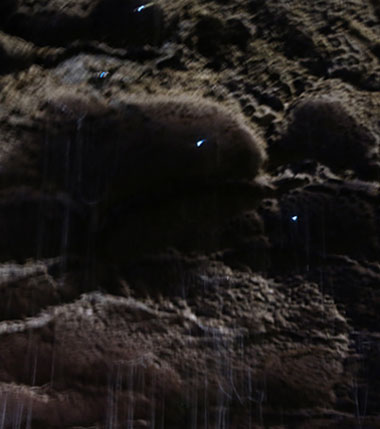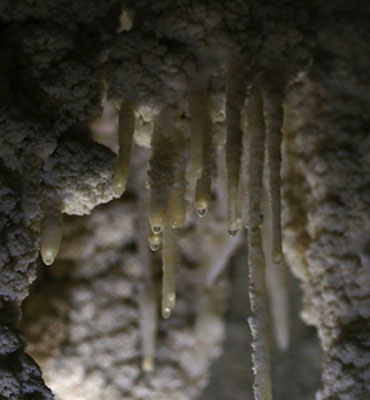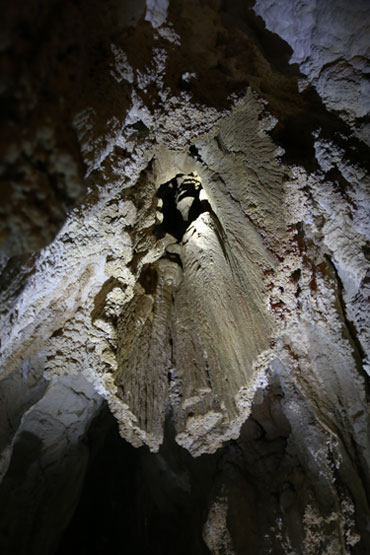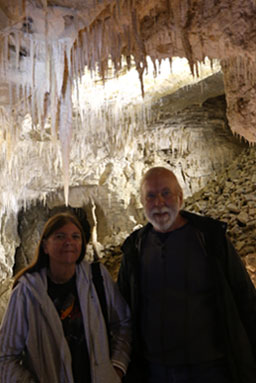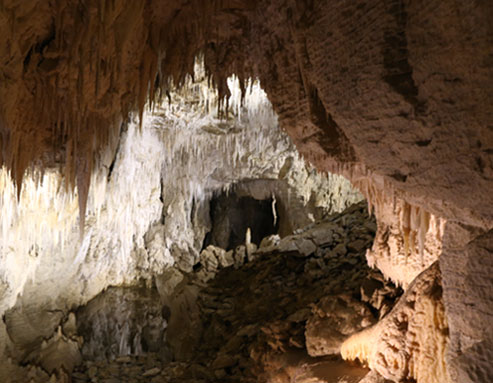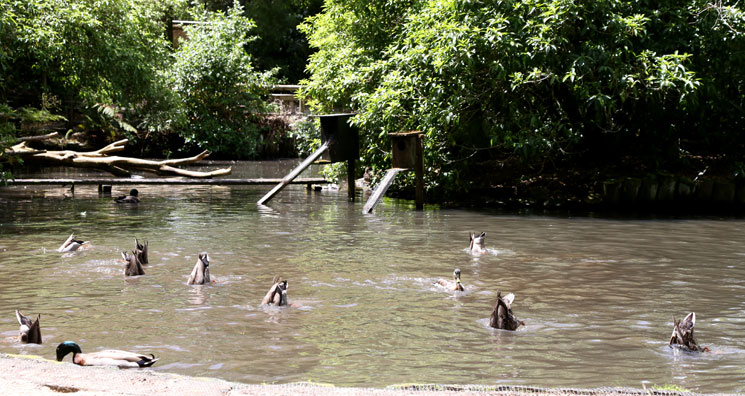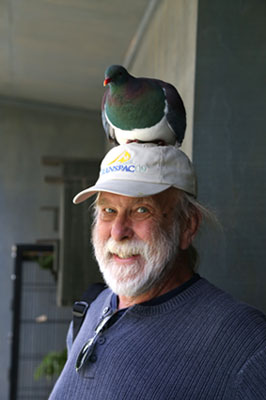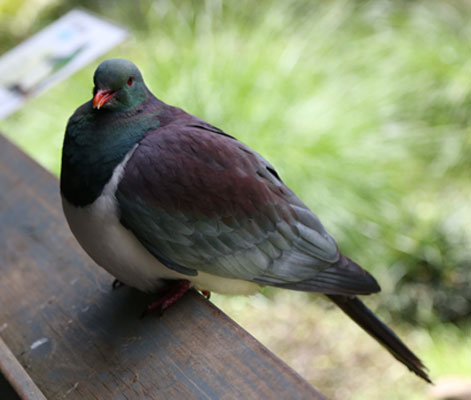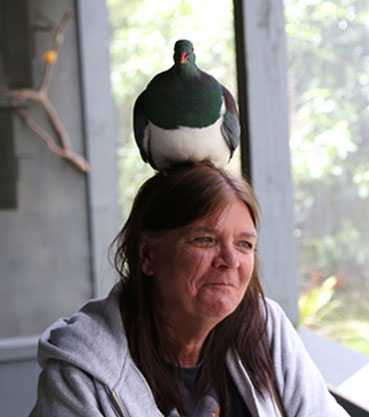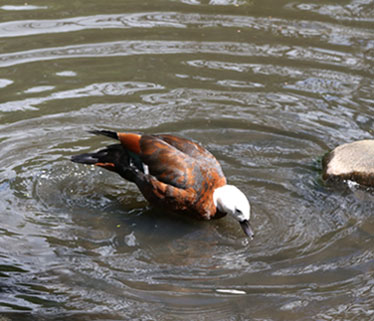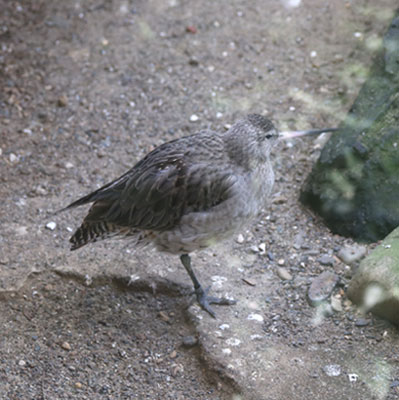Ruakuri Cave and Otorohanga Kiwi House & Native Bird Park
Ruakuri Cave was discovered 400-500 years ago by a young Māori warrier who was traveling with a war party.
He was attacked by a pack of wild dogs while he was hunting so he threw his kill
to divert their attention and ran away. He later returned with reinforcements and tracked the dogs to their
cave. The dogs were killed, and their skins were made into a cape for the chief.
Over the years, the cave's entrance provided shelter for travelers, and the interior was used as a burial site.
The cave has been modified to provide access for just about everyone. After entering through the secure
doors, a long spiral ramp wide enough to accomodate most wheelchairs, descends into the darkness. We didn't get
a good picture of the ramp, so I copied the picture on the right from the Waitamo Caves website.
Ruakuri is a wet cave, so we were able to get a good closeup look at glowworms during our tour.
The New Zealand glowworm spends 6 to 12 months - the longest part of its life - in a larval state. During this period
it spins a nest of dangling silken threads and glows in the hope of attracting prey like midges and mosquitos. After
this phase, it briefly turns into a pupa, emerges as an adult, mates, lays eggs, and dies all within two or three weeks.
More adventurous tourists can participate in activities such as black water rafting and abseiling, and as we enjoyed our more
sedate underground experience, we occasionally heard their screams in the distance.
Near the end of the tour, the guide took pictures of everyone in front of this impressive scene.
We had several hours to kill before heading off to the hotel near the Auckland Airport where we would spend
the final night of our trip. We hadn't really made any plans, but I had seen a sign for the Otorohanga Kiwi
House & Native Bird Park located in a nearby town, and it looked like it might be interesting. The park serves
as a sanctuary and operates a breeding program for New Zealand's native birds and reptiles.
It turned out to be a delightful place, and the perfect end to our trip.
Just inside the entrance was a large pond full of ducks who were doing their best to ignore some boisterous young
children who were enthusiastically hurling food in their direction. As soon as the children lost interest and
ran off down the path, all the ducks stuck their heads in the water and their tails in the air as they dived for
the food. Most amusing.
Next up was a small aviary where we encountered the same over-excited children. The birds huddled in the corner and
watched aprehensively. The children soon left and silence fell.
We were reading this sign about the wood pigeon, when suddenly there was a loud flapping of wings and the large, heavy bird plopped
onto Walt's head.
Best of all, we finally saw a kiwi. Since kiwi are active at night and sleep during the day, the park displays four of the elusive
creatures in a nocturnal house. Three are somewhat shy and stayed mostly out of sight, but the great spotted kiwi, known as Atu, is
quite active. My first glimpse of her on the distant side of the dimly lit enclosure was quite surprising. If I didn't know there
was a kiwi in there, I would have thought she was a rabbit.
At a designated time, a keeper wearing leather leggings appeared to give a short talk, feed the birds, and answer any questions people
might have. She explained that kiwi are very territorial and that when she climbed over the fence, the bird would come rushing at her and
attempt to drive her away.
Sure enough, as soon as the keeper put her foot inside the enclosure, Atu came running at her full speed and began kicking and biting.
She had figured out that if she jumped up she could reach above the leggings and deliver a bite that would make the keeper wince.
It was an impressive display of agression.
When the keeper emerged she said "First let me answer the question every group asks. Yes, it hurts, but I don't mind so much because I
feel honored to be able to interact with the kiwi."
You aren't allowed to take pictures in the Nocturnal House, but here's a picture of Atu from the website. Apparently there is one
keeper she allows to pet her.
Below are some pictures of other birds we saw in the park.
We had talked about going to New Zealand for about 12 years before finally making this trip. Don't wait that long. It's an
incredibly beautiful and fascinating country.
